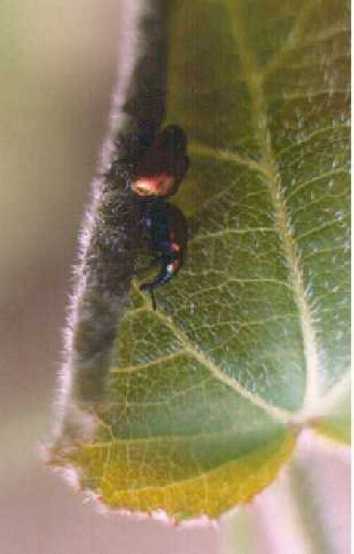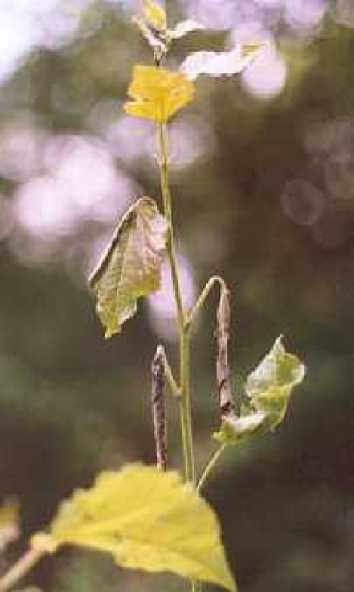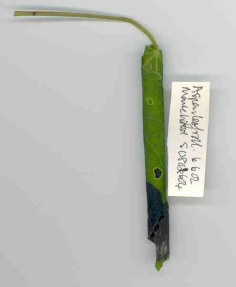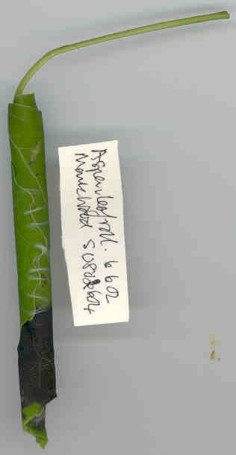BYCTISCUS POPULI: THE STATUS AND BIOLOGY OF A RARE
SPECIES ACTION PLAN (SAP) WEEVIL IN WORCESTERSHIRE.
Jon Mellings
LEFT: B. populi adults constructing leaf roll, Monkwood,
Worcester, June 2001
RIGHT: Aspen sucker with leaf rolls and new roll in the
process of construction, Monkwood, Worcester, June 2001
Introduction
Byctiscus populi (Coleoptera: Attelibidae) an
attractive, metallic green or coppery coloured, leaf-rolling
weevil associated with Aspen Populus tremula and White
Poplar Populus alba, has suffered serious decline in the
UK in the past few decades. It is now classified as RDB3 'rare'
and is the subject of its own SAP - 'Species Action Plan' (Morris,2001).
In response to specifications in the SAP, research is currently
being carried out at Leeds University, English Nature's lead
partner for this species. Many former, extant and potential sites
have been surveyed to update records, and a truer picture of the
species' current status has emerged. Results from this survey
together with research into aspects of the biology and habitat
preferences of this weevil, will be used to advise practical
management actions necessary to aid recovery of B. populi's
UK populations.
Site surveys
During the summers of 2001 and 2002 more than twenty sites were
surveyed nationally. Of only six sites where B. populi
survives, two have been located in Worcestershire. Whereas the
remaining U.K. populations of this weevil, one in Warwickshire
and the remaining three in B. populi's former stronghold
of south east England, are very small and in danger of
extinction, both Worcester populations are thriving.
Worcestershire sites
A common feature of historic and extant B. populi
populations is that they have, with very few exceptions, occupied
ancient woodlands or common land with a history of coppicing.
Interestingly, there are several parallels between the two
Worcestershire sites. Monkwood and Trench Wood have very similar
management histories; they are both ancient coppice woodlands
that were managed by Harris the brush-makers in the post war
period, before being taken over by Worcestershire Wildlife Trust
and Butterfly Conservation.
Identification
B. populi is one of only two British representatives of
the genus. Both are compact, metallic weevils with squarish
elytra and straight rather than elbowed antennae. Byctiscus males
are characterized by the presence of a conspicuous, forward-pointing
spine on the lower margin of the pronotum in the anterior third
on each side. This feature is a particularly useful
identification aid, being unique to Byctiscus in this group. B.
populi's sister species B. betulae is very similar to B. populi
which can be distinguished by the inky blue-black underside
contrasting markedly with the typically greenish or coppery
coloured upper surface. B. betulae is normally a uniform metallic
blue in the male and metallic green or golden green in the
female, the underside being concolorous with the upper surface in
both sexes. Whereas the elytral apices are entirely glabrous in B.
populi, in B. betulae these are sparsely clothed with fine, pale
pubescence. B. betulae tends also to be a somewhat larger species
of 4.8-7mm compared with 4-5.5mm in B. populi.
Life History
Adult beetles appear around the beginning of May and can be found
from this time onwards until the end of September. The weevils
then feed on the developing aspen leaves before commencing to
construct neat, cigar-like leaf rolls into which 1-4 pearly white
eggs are deposited on the innermost edge. Prior to rolling, the
female weevil punctures the petiole causing the leaf to wither.
The eggs hatch after about a week and the creamy white larvae
begin to feed in earnest on the decaying leaf. At some point
during the larval development the roll falls to the ground, the
larva continues to feed before burrowing beneath the soil to
pupate.
Leaf rolls are continually produced throughout the summer but
peak activity is between June and July, activity trailing off
considerably and ceasing around mid-September. In captivity, B.
populi specimens were found to take as little as one month
to develop from egg to adult at room temperature, so it seems
probable that peak activity at the end of June and beginning of
July corresponds to the emergence of individuals developed from
eggs laid by the over-wintering brood in May. Captive reared
adults emerging in August were successfully hibernated in outdoor
conditions in late October. Given a choice of rough bark and
sandy soil, weevils hibernated both just beneath the soil and
within cracks in the bark. Despite this, the lack of late season
records of B. populi adults, may indicate that the
majority of late brood weevils remain beneath the ground until
the following year. Bily (1990) states that this is the case with
B. betulae.
Habitat choice
B. populi's need to produce leaf rolls is evidently
important in determining the weevil's choice of habitat as it is
linked to the early successional stages of aspen. The weevil
almost exclusively uses newly regenerating aspen 'suckers' for
leaf rolling. In contrast to more mature aspens which produce few
new leaves after the initial Spring bud-burst, in their first two
years of growth suckers produce a continual supply of new leaves
throughout B. populi's flight season. Importantly,
pliable new leaves are much easier to roll than older ones,
furthermore, the leaves of young suckers tend to be much larger
than those of mature aspens and older suckers. Interestingly, a
study by Evans (2001) of B. populi in Latvia, showed
that more eggs tended to be laid in longer leaves. Meanwhile, in
Monkwood two or more females were occasionally observed to
cooperate in the rolling of a single large sucker leaf.
The low sucker growth is also beneficial in providing a warm,
sheltered microclimate. Like many thermophilous invertebrates, B.
populi becomes more active as temperature increases.
Although sexual activity and roll production continues throughout
periods of cooler weather and even in moderately wet conditions,
in periods of direct sunlight activity speeds up markedly,
weevils fly readily in such conditions and have been observed to
fly for 100 metres or more on occasions. In June and July they
are active for long hours, continuing to produce rolls throughout
the day from early morning until dusk.
Habitat management
B. populi is another example of a species which suffered
greatly from the decline of traditional woodland practices in the
latter half of the last century. Surveying has revealed that the
beetle has disappeared from former strongholds which have become
shaded. A good example in Worcestershire is Worcestershire
Wildlife Trust owned Randan Wood near Kidderminster where B.
populi was recorded in 1951 by Fred Fincher. Whilst both
mature aspen and suckers still occur, albeit thinly on this site,
the lack of light penetration evidently led to the demise of the
weevil. (Fred Fincher allowed parts of the wood to develop
naturally long before it became a WWT reserve - Ed)
Being a species associated with early successional re-growth, B.
populi seems well adapted to survival in a dynamic habitat.
The rotationally managed ride and coppice system of Monkwood and
Trench wood seems very suitable for the insect and in mid-summer
ride edges and young coppice stands in parts of the reserve are
festooned with B. populi leaf-rolls. The weevil may have
benefited from the open habitat created during the Harris brush
era at a time when many other former coppice woods were neglected.
At Monkwood the beetle may also have inadvertently benefited from
management for the Wood white butterfly Leptidea sinapis
which favours a patchy ride edge habitat of tall grasses and
light scrub. An overall impression is that the weevil is perhaps
more at home on ride edges than in all but the earliest stages of
the coppice cycle. This may partially explain why this species
has died out in sites like Bradfield Wood in Suffolk. Although
this site has been continuously coppiced since mediaeval times,
the ride edges are regularly manicured and kept almost entirely
scrub-free.
At present a report detailing work completed over the past two
field seasons at Monkwood and other sites is being prepared for
English Nature. Plans for the next year include a large scale G.I.S.
habitat mapping project to establish the whereabouts and
condition of habitat suitable for B. populi, in
woodlands in the areas surrounding core sites such as Monkwood
and Trench wood. Any information regarding Byctiscus populi
records in the Worcester area would be gratefully received.
References
BILY, S.,1990. A colour guide to beetles, ed. London:
Hamlyn.
EVANS, L. 2001, A study on Byctiscus populi (L.1758) (Attelabidae)
in Latvia and implications for conservation management in the UK.
Unpublished MSc. project, University of Leeds.
MORRIS, M.G., 1999, Byctiscus populi (a leaf-rolling weevil)
Action plan. In UK Biodiversity Group Tranche 2 Action Plans, Vol
5: Invertebrates (March 1999). Peterborough: JNCC.
Contacts:
Jon Mellings. Email: jonmellings@btopenworld.com
Dr Steve Compton. Email: pab6sgc@leeds.ac.uk
Or locally Helen Woodman or Harry Green at Worcestershire
Wildlife Trust.
The map below shows national distribution of B. populi (all
records)
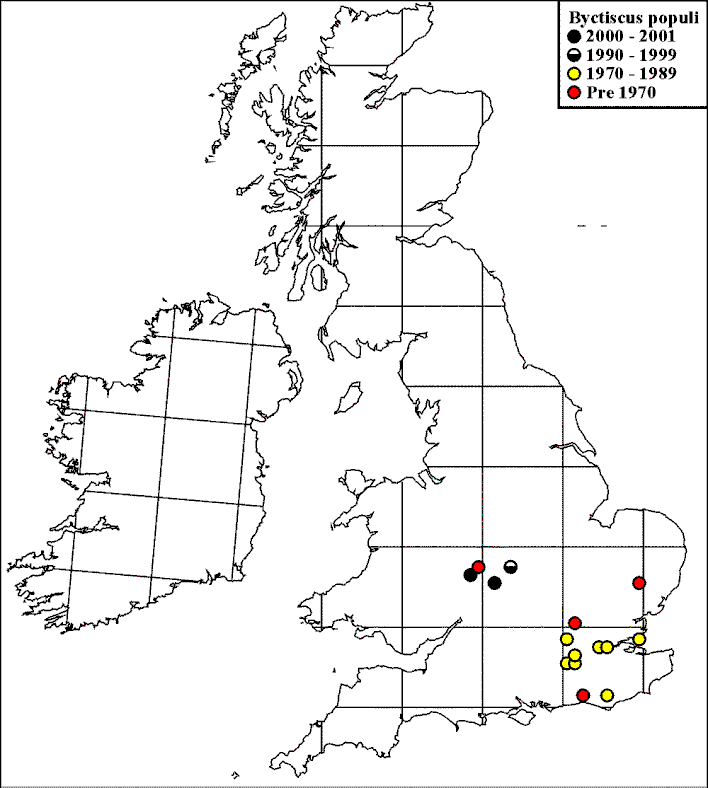
ASPEN LEAF ROLLS
On a Management Committee visit to Monkwood on 6th June 2002 we
noticed the leaf rolls on young aspen as shown in the pictures.
At that time we were not sure what Bycticus populi rolls looked
like so I sent a picture to Jon Mellings for comment - see the
footnote to his article. Following his response I sent the
pictures to Tony Simpson who said that the most likely causer was
a micro-moth Anacampsis populella (Fam Glechidae) which produces
95% of aspen leaf rolls. Less likely was one of two species of
Tortricinae, which also make aspen leaf rolls. If any reader sees
rolls in Worcestershire resembling B. populi please let us know
as a matter of urgency - thank you. Harry Green
